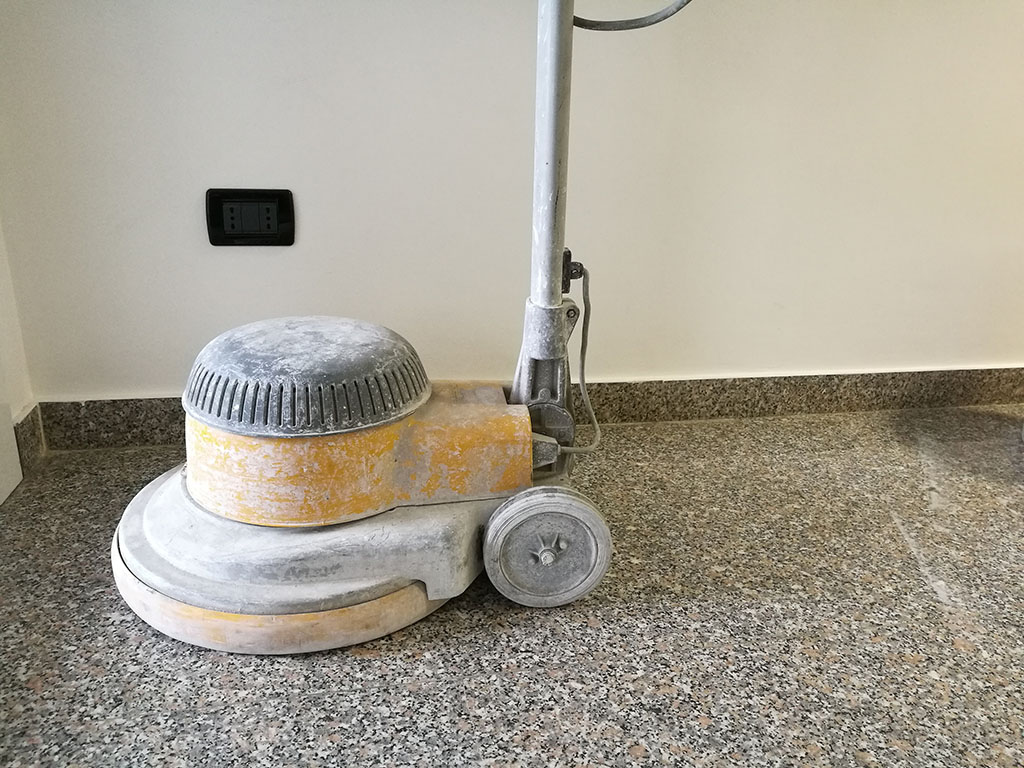Getting ready to coat your concrete floor? Do This First:
Step 4 – Profiling: For a professionally installed floor, grinding is a must

07-05-2017
Article 5 of 5 in a series
If you've been following along with this series, you've already taken multiple steps toward preparing your concrete floor for coating, including: 1) testing for moisture, 2) making any repairs, and 3) thoroughly cleaning its surface. (If you're new to the series, be sure to complete steps 1-3 first!)
Even if it's newly installed and needs no repairs or additional cleaning, your concrete isn't ready to coat until its "pores" are reopened, a process known as profiling. Akin to pre-treating wood to better accept a stain, profiling, or opening the pores of concrete surfaces, allows coatings to penetrate and achieve a proper bond.
There are two main profiling methods: grinding and acid etching. In this article, we'll discuss why – if you professionally coat your floor – grinding is the way to go.
But first: what are concrete pores?
As this article from Radon Seal explains, after new concrete is poured, the water in it slowly evaporates. "As this surplus water pushes to the surface, it leaves behind a network of capillary pores in the concrete." These invisible pores, with diameters smaller than human hair, constitute 12–18%+ of concrete.
Most concrete is then finished, smoothing the surface and thereby closing its pores. Removing this top layer, or profiling, exposes the pores. Without profiling, coatings fail.
Grinding refers to mechanical techniques that polish the surface of the concrete, removing glues, paints, sealants, laitance, and other contaminants that can impact the success or failure of your floor coating. (Laitance is a weak layer of cement and aggregate fines.) Tools vary depending on the size, budget and type of flooring project, and include shot blasters, planers or handheld tools with rotating diamond-head discs.
Grinding is widely accepted as the most consistent, effective method for profiling your concrete floor. It removes all contaminants, including sealants and laitance, that prevent floor coatings from properly bonding with the substrate. Grinding also offers better control of the final profile uniformity and desired surface texture.
What about acid etching?
When you do your research, or if you work with a contractor looking to trim costs, acid etching inevitably emerges as an easier, cheaper chemical alternative to grinding: profiling the concrete surface by pouring an acid solution over it.
Although acid etching is arguably easier to perform and a lower initial investment, Citadel doesn't recommend acid etching for any but small, DIY projects.
With acid etching, varying porosity in different areas of the floor can lead to differing textures and a nonuniform surface. Also, mechanical grinding is the only profiling method that removes sealant and all traces of laitance—both of which will prevent coatings from properly bonding with the concrete.
For the professionally coated floor, mechanical grinding is therefore the only way to go.
Wondering which grind process to choose for your project? Citadel offers multiple, easy-to-use handheld tools – as well as a safe acid etching solution when the project calls for it. Click here to schedule a free consultation with one of our experts to recommend the best tool for the size, type and budget of your professional, concrete floor coating project.
Latest News
How to Maintain Your Concrete Grinder
Gain Customers and Referrals in 4 Easy Steps
Ready for the Summer Rush? 4 Ways to Prepare
6 Cold Weather Safety Tips for Installers
How to Remove Salt Stains from Concrete
Testimonials
Every time I call I get to talk to someone, and I always have an answer within 20 minutes. That's awesome.
Client: Terry C.

